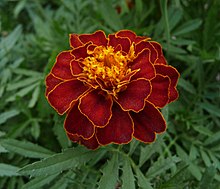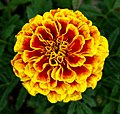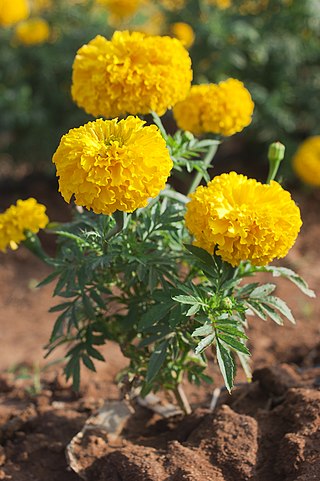
Tagetes is a genus of 50 species of annual or perennial, mostly herbaceous plants in the family Asteraceae. They are among several groups of plants known in English as marigolds. The genus Tagetes was described by Carl Linnaeus in 1753.

Osteospermum, is a genus of flowering plants belonging to the Calenduleae, one of the smaller tribes of the sunflower/daisy family Asteraceae. They are known as the daisybushes or African daisies. Its species have been given several common names, including African daisy, South African daisy, Cape daisy and blue-eyed daisy.

Chamaecyparis obtusa is a species of cypress native to central Japan in East Asia, and widely cultivated in the temperate northern hemisphere for its high-quality timber and ornamental qualities, with many cultivars commercially available.

Hyacinthus orientalis, the common hyacinth, garden hyacinth or Dutch hyacinth, is a species of flowering plant in the family Asparagaceae, subfamily Scilloideae, native to southwestern Asia, southern and central Turkey, northwestern Syria, Lebanon and northern Palestine. It was introduced to Europe in the 16th century. It is widely cultivated everywhere in the temperate world for its strongly fragrant flowers which appear exceptionally early in the season, and frequently forced to flower at Christmas time.

Hosta is a genus of plants commonly known as hostas, plantain lilies and occasionally by the Japanese name gibōshi. Hostas are widely cultivated as shade-tolerant foliage plants. The genus is currently placed in the family Asparagaceae, subfamily Agavoideae, and is native to northeast Asia. Like many "lilioid monocots", the genus was once classified in the Liliaceae. The genus was named by Austrian botanist Leopold Trattinnick in 1812, in honor of the Austrian botanist Nicholas Thomas Host. In 1817, the generic name Funkia was used by German botanist Kurt Sprengel in honor of Heinrich Christian Funck, a collector of ferns and alpines; this was later used as a common name and can be found in some older literature.

Tagetes tenuifolia, the signet marigold, golden marigold or lemon marigold, is a species of the wild marigold in the family Asteraceae. It is widespread across most of Mexico as well as Central America, Colombia, and Peru.

Celosia argentea, commonly known as the plumed cockscomb or silver cock's comb, is a herbaceous plant of tropical origin in the Amaranthaceae family from India and Nepal. The plant is known for its very bright colors. In India and China it is known as a troublesome weed.

Tagetes erecta, the Aztec marigold, Mexican marigold, big marigold, cempaxochitl or cempasúchil, is a species of flowering plant in the genus Tagetes native to Mexico and Guatemala. Despite being native to the Americas, it is often called the African marigold. In Mexico, this plant is found in the wild in the states of México, Michoacán, Puebla, Veracruz and Guerrero.

Lavandula angustifolia, formerly L. officinalis, is a flowering plant in the family Lamiaceae, native to the Mediterranean. Its common names include lavender, true lavender and English lavender ; also garden lavender, common lavender and narrow-leaved lavender.
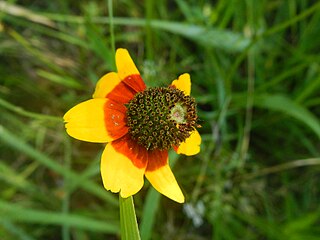
Dracopis is a monotypic genus with Dracopis amplexicaulis the sole species. It is native to North America.

Papaver nudicaule, the Iceland poppy, is a boreal flowering plant. Native to subpolar regions of Asia and North America, and the mountains of Central Asia as well as temperate China, Iceland poppies are hardy but short-lived perennials, often grown as biennials. They yield large, papery, bowl-shaped, lightly fragrant flowers supported by hairy, 1 foot (30 cm) curved stems among feathery blue-green foliage 1–6 inches long. They were first described by botanists in 1759. The wild species blooms in white or yellow, and is hardy from USDA Zones 3a-10b.

Berberis thunbergii, the Japanese barberry, Thunberg's barberry, or red barberry, is a species of flowering plant in the barberry family Berberidaceae, native to Japan and eastern Asia, though widely naturalized in China and North America, where it has become a problematic invasive in many places, leading to declines in species diversity, increased tick habitat, and soil changes. Growing to 1 m tall by 2.5 m broad, it is a small deciduous shrub with green leaves turning red in the autumn, brilliant red fruits in autumn and pale yellow flowers in spring.

Calendula officinalis, the pot marigold, common marigold, ruddles, Mary's gold or Scotch marigold, is a flowering plant in the daisy family Asteraceae. It is probably native to southern Europe, though its long history of cultivation makes its precise origin unknown. It is also widely naturalised farther north in Europe and elsewhere in warm temperate regions of the world.
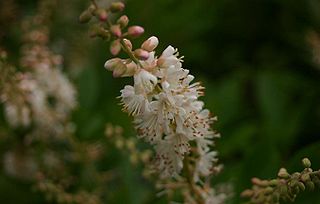
Clethra alnifolia, the coastal sweetpepperbush or summer sweet, is a species of flowering plant in the genus Clethra of the family Clethraceae, native to eastern North America from southern Nova Scotia and Maine south to northern Florida, and west to eastern Texas. It is a deciduous shrub which grows in wetlands, bogs and woodland streams.

Tagetes lucida is a perennial plant native to Mexico and Central America. It is used as a medicinal plant and as a culinary herb. The leaves have a tarragon-like scent, with hints of anise, and it has entered the nursery trade in North America as a tarragon substitute. Common names include sweetscented marigold, Mexican marigold, Mexican mint marigold, Mexican tarragon, sweet mace, Texas tarragon, pericón, yerbaniz, and hierbanís.
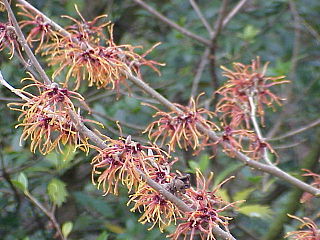
Hamamelis×intermedia, the hybrid witch hazel, is a flowering plant in the family Hamamelidaceae. It is a hybrid of garden origin between H. japonica and H. mollis. Its Latin name refers to its intermediate appearance between those two species.

Myrtus communis, the common myrtle or true myrtle, is a species of flowering plant in the myrtle family Myrtaceae. It is an evergreen shrub native to southern Europe, North Africa, Western Asia, Macaronesia, and the Indian Subcontinent, and also cultivated.

Hydrangea paniculata, or panicled hydrangea, is a species of flowering plant in the family Hydrangeaceae native to southern and eastern China, Korea, Japan and Russia (Sakhalin). It was first formally described by Philipp Franz von Siebold in 1829.

Syringa pubescens is a species of flowering plant in the lilac genus of the family Oleaceae, native to Korea and China.
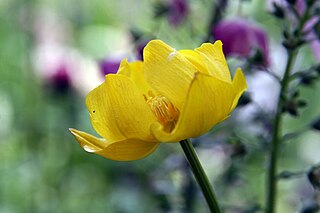
Trollius × cultorum is a group of hybrid flowering plants of garden origin, belonging to the buttercup family Ranunculaceae. There are several cultivars, derived from T. europaeus, T. asiaticus and T. chinensis. These are clump-forming herbaceous perennials whose preferred location is heavy, moist or even boggy ground, in full sun or partial shade. Typically growing to 60 cm (24 in) tall, they bear showy double flowers up to 6 cm (2.4 in) in diameter. Flowers appear in shades of cream, yellow and orange. The curved “petals” are actually sepals, surrounding the smaller, nectar-bearing petals. The spherical or cupped shape of the blooms gives rise to the common name globeflower, which they share with other Trollius species.


